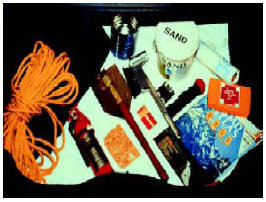|
Effects of winter storms
Severe winter storms can cause widespread damage and disruption.
Heavy snow often results in paralyzed transportation systems,
automobile accidents due to slippery roads, and stranded vehicles.
Glazing from ice storms topples utility lines and poles and makes
travel virtually impossible. These conditions can be a threat to
life. Nearly 80 people in the United States die from winter storms
and extreme cold every year, which is more than the fatalities due
to tornadoes!
The hazards posed by winter storms and extreme cold can be
catastrophic. However, you can take actions now that will increase
your chances of surviving winter storms and extreme cold.

Before a winter storm or extreme cold
-
Know the
terms relating to winter storms and extreme
cold.
-
Know the names of the
counties where you live, work and visit frequently. County names
are used to identify areas at risk.
-
Learn how to protect
your family's health during the winter months:
-
Gather emergency
supplies for work or home:
-
A battery-powered
NOAA weather radio and a battery-powered commercial radio and
extra batteries. These may be your only links to the outside
world if electrical service is interrupted.
-
Foods that do not
require cooking or refrigeration are best. Include high-energy
foods such as dried fruit and candy.
-
Extra medications and
special items for babies, the disabled or elderly.
-
Extra water in clean
containers.
-
Rock salt to melt ice
on walkways and sand to improve traction.
-
Flashlights and extra
batteries. Do not use candles; they are a fire hazard.

-
Winterize your home
to extend the life of your fuel supply:
-
Insulate walls and
attics.
-
Caulk and
weatherstrip doors and windows.
-
Install storm windows
or cover windows with plastic.
-
Take steps to prevent
frozen water pipes:
-
Locate and insulate
pipes most susceptible to freezing -- typically those near outer
walls, in crawl spaces or in attics.
-
Wrap pipes with
UL-approved heat tape.
-
Seal any leaks that
allow cold air inside where pipes are located.
-
Disconnect garden
hoses, and shut off and drain water from pipes leading to
outside faucets. This reduces the chance of freezing in the
short span of pipe just inside the house.
-
Make sure you and
your family know how to shut off the water, in case pipes burst.
-
Prepare for possible
isolation in your home:
-
Make sure you have
sufficient heating fuel. After a severe winter storm, regular
fuel carriers may not reach you for days.
-
Have emergency
heating equipment (fireplaces, wood burning stoves or space
heaters) and ample fuel so you can keep at least one room of
your house warm enough to be livable. Always ensure proper
ventilation.
-
Keep fire
extinguishers on hand, and make sure your family knows how to
use them.
-
Prepare your vehicle
for the winter:
-
Winterize your
vehicle, following the suggested maintenance schedule included
in the owner’s manual, or have your vehicle serviced by a
reputable dealer, garage or mechanic.
-
Check your wipers,
tires, lights and fluid levels (radiator, windshield washer,
power steering, oil and brakes) regularly. Make sure the brakes
and transmission are working properly. Lubricate door and trunk
locks with lock lubricant to prevent them from freezing.
-
Prepare a
winter storm survival kit and carry it in
your vehicle.
During a winter storm and extreme cold
Listen to the radio or television for weather reports and
emergency information. Dress for the season.
When at home
-
Stay indoors as much as possible.
-
Conserve fuel if necessary by keeping your house cooler than
normal. Temporarily "close off" heat to some rooms.
-
Hang blankets over windows at night (let the sun shine in during
the day). Stuff cracks around doors with rugs, newspapers, towels or
other such material.
-
When using alternative heat from a fireplace, wood stove or space
heater, use safeguards and ensure proper ventilation.
-
Refuel kerosene heaters outside, and keep them at least three
feet away from flammable objects.
-
If you have no heat, close off unneeded rooms and place towels or
rags under the doors. Cover windows at night.
-
Eat to supply heat, and drink nonalcoholic beverages to avoid
dehydration.
-
If your water pipes freeze:
-
Shut off water at the main source. This can minimize the damage
to your home.
-
Call a plumber and contact your insurance agent.
-
Never try to thaw a frozen pipe with an open flame or torch.
-
Always be careful of the potential for electric shock in and
around standing water.
Outside
-
Avoid overexertion, such as shoveling heavy snow, pushing a car
or walking in deep snow. At any age, the strain from the cold and
the hard labor could cause a heart attack -- a major cause of death
in the winter. Sweating can lead to a chill and even hypothermia.
-
Watch for signs of frostbite and hypothermia.
-
If you become stranded:
-
Seek shelter to stay dry.
-
Cover all exposed parts of the body.
-
If no shelter is nearby, prepare a lean-to, windbreak or snow
cave for protection from the wind. Build a fire for heat and to
attract attention.
-
Do not eat snow, as it will lower your body temperature. Melt it
first.
On the farm
-
Move animals to sheltered areas.
-
Haul extra feed to nearby feeding areas.
-
Have a water supply available. Most animal deaths in winter
storms occur from dehydration.
When traveling
If you decide a trip cannot be delayed, consider using public
transportation. If you decide to drive your vehicle:
-
Before you leave
-
Plan your travel and check the latest weather conditions along
your travel route. Listen to weather forecasts on TV, local radio
stations or NOAA Weather Radio. Call 1-800-452-IDOT (4368) to get
current road conditions for Illinois' interstate and freeway
systems. Information is updated every two hours during a storm.
Winter driving is often the most difficult due to rain, fog, snow or
sleet.
-
Check your wipers, tires, lights and fluid levels (radiator,
windshield washer, power steering, oil and brakes). Lubricate door
and trunk locks with lock lubricant to prevent them from freezing.
-
Travel during daylight hours on main roads (avoid back-road
shortcuts) and don't travel alone.
-
Carry a
winter storm survival kit in your vehicle.
-
Provide your itinerary to a friend, relative or co-workers.
Include information on where you are going, the routes you will
travel and when you expect to arrive. When you reach your
destination, make a call to report that you have arrived.
-
Start your trip with a full tank of gas.
-
On the road
-
Buckle your seat belts
-
Be prepared to turn back and seek shelter if conditions become
threatening.
-
Keep your windows clear of snow and ice. Do not start until your
windshield is defrosted.
-
Drive slower and increase your following distance. Your speed
should be adjusted for the conditions and match the flow of traffic.
-
Roadway conditions may vary depending on the sun, shade or
roadway surface. Watch for slick spots, especially under bridges, on
overpasses and in shaded spots. Be prepared to react to
deteriorating conditions.
-
If the pavement is snow- or ice-covered, start slowly and brake
gently. Begin braking early when you come to an intersection. If you
start to slide, ease off the gas pedal or brakes. Steer into the
direction of the skid until you feel you have regained traction;
then straighten your vehicle.
-
When a snowplow is coming toward you, allow plenty of room for
the truck to pass. When the centerline is being cleared and salted,
remember that the plow tip may be on or over the line.
-
When you approach a snowplow from behind, pass with care and only
when you can see the road ahead of the truck. You should not try to
pass in blowing snow; there may be a vehicle in that cloud of snow.
Allow more distance between you and the plow, which may be spreading
salt.
-
While traveling, refuel often -- keeping your gas tank near full
to prevent ice in the tank and fuel lines, which could leave you
stranded. These frequent stops should relieve tense muscles.
-
If stranded
-
Pull as far off the road as possible, set your hazard lights to
"flashing," and hang or tie a colored cloth (preferably red) to your
antenna, window or door. After snow stops falling, raise the hood to
indicate trouble.
-
If you have a cellular phone, call for help.
-
Stay in your vehicle, where rescuers are most likely to find you.
Do not set out on foot unless you can see a building close by where
you know you can take shelter. Be careful. Distances are distorted
by blowing snow. A building may seem close but be too far to walk to
in deep snow. Visibility can diminish quickly in wind-driven snow.
This, added to the cold, can leave you disoriented.
[to top of second column] |

- (Continued: On the road -- If stranded)
-
Make sure the exhaust pipe is not blocked by snow; then run the
engine and heater about 10 minutes each hour to keep warm. Turn on
the dome light at night when running the engine. When the engine is
running, open a window slightly for ventilation. The fresh air will
protect you from carbon monoxide poisoning. Periodically clear away
snow from the exhaust pipe.
-
Use items in your
winter storm survival kit.
-
Exercise to keep blood circulating and to maintain body heat by
vigorously moving arms, legs, fingers and toes. In extreme cold or
if you don't have a winter storm survival kit, use road maps, seat
covers and floor mats for insulation. Huddle with passengers and use
your coats as blankets.
-
Take turns sleeping. One person should be awake at all times to
look out for rescue crews.
-
Be careful not to use up battery power. Balance electrical energy
needs -- the use of lights, heat and radio -- with supply.
-
If stranded in a remote rural area or wilderness area, spread a
large cloth over the snow to attract attention of rescue personnel
who may be surveying the area by airplane. Once the blizzard passes,
you may need to leave the vehicle and proceed on foot.
Winter storm survival kit for travelers

-
Cell phone and
charger
-
Blankets, sleeping
bags
-
Flashlight with extra
batteries
-
First-aid kit
-
Knife
-
High-calorie,
nonperishable food
-
Extra clothing to
keep dry
-
A large empty can and
plastic cover with tissues and paper towels for sanitary
purposes
-
A smaller can and
waterproof matches to melt snow for drinking water
-
Sack of sand or cat
litter
-
Shovel
-
Windshield scraper
and brush
-
Tool kit
-
Tow rope
-
Booster cables
-
Water container
-
Compass and road maps

 Winter weather terms Winter weather terms
The National Weather Service uses the terms below to convey the
weather threat to the public. It is important that everyone
understands these terms and knows what protective actions need to be
taken.
Winter storm watch -- Indicates severe winter weather such
as heavy snow or ice is possible within the next day or two.
Prepare now.
Winter storm warning -- Indicates severe winter weather
conditions are occurring, imminent or highly likely. Stay
indoors.
Heavy snow warning -- Snowfall of 6 inches or more in
north and central Illinois, 4 inches or more in southern Illinois.
Ice storm warning -- Heavy accumulations of ice will
create extremely dangerous travel and damage trees and power lines.
Blizzard warning -- Snow and strong winds will combine to
produce blinding snow, near-zero visibility, deep drifts and
life-threatening wind chill.
Wind chill warning -- Life-threatening wind chills of 25
below zero or colder.
Snow advisory -- Snowfall of 3 to 5 inches in northern and
central Illinois, 2 to 4 inches in southern Illinois.
Winter weather advisory -- Indicates winter weather
conditions will cause significant inconveniences and may be
hazardous, especially to motorists. Use caution.
Wind chill advisory -- Dangerous wind chills of 15 to 24
below zero.
Freezing rain advisory -- Light accumulations of ice will
cause hazardous travel.
Blowing and drifting snow advisory -- Poor visibility and
hazardous driving conditions.
Freezing fog advisory -- Very light ice accumulation on
roadways, bridge decks and overpasses, predominantly from fog,
causing hazardous travel.
Wind chill -- A calculation of how cold it feels outside
when the effects of temperature and wind speed are combined.
Freezing rain -- Rain that freezes upon impact with the
ground, creating a coating of ice on roads and walkways.
Sleet -- Pellets of ice created by frozen raindrops. Sleet
bounces when hitting a surface and does not stick to objects. An
accumulation of sleet can make roads slick and hazardous.
 Recommended winter attire Recommended winter attire
-
Wear loose-fitting,
lightweight, warm clothing in several layers (the trapped air
between the layers insulates). Layers can be removed to avoid
perspiration and subsequent chill.
-
Wear outer garments
that are tightly woven, water-repellent and hooded.
-
Wear a hat (half of
body heat is lost through the top of the head).
-
Wear mittens that are
snug at the wrist. Mittens offer better protection. Gloves allow
your fingers to cool much faster than mittens do.
-
Cover the mouth and
nose with scarves to help protect lungs from cold air.
-
Attempt to keep your
feet as dry as possible. Wear wool socks.
Frostbite and hypothermia
Frostbite is a severe reaction to cold exposure of the skin,
which can permanently damage fingers, toes, the nose and ear lobes.
Symptoms are numbness and a white or pale appearance to the skin.
When symptoms are apparent, seek medical help immediately. If
medical help is not immediately available, slowly warm the affected
areas.
Hypothermia, or low body temperature, is a condition brought
on when the body temperature drops to less than 95 degrees. Symptoms
include slow or slurred speech, incoherence, memory loss,
disorientation, uncontrollable shivering, drowsiness, repeated
stumbling, and apparent exhaustion. If these symptoms are detected,
take the person's temperature. If it is below 95 degrees,
immediately seek medical attention. If medical help is not
available, begin warming the person slowly. Always warm the body
core first. Get the person into dry clothing and wrap them in a warm
blanket covering the head and neck. Do not give the victim alcohol,
drugs, coffee or any hot beverage. Warm broth is better. Do not warm
extremities (arms and legs) first. This drives the cold blood toward
the heart and can lead to heart failure.
Wind chill
Most of the time, cold is judged in terms of a thermometer
reading. With people and other living things, though, both
temperature and wind speed are needed to produce a "wind chill
factor." The wind chill is based on the rate of heat loss from
exposed skin, caused by the combined effects of the wind and cold.
As the wind increases, heat is carried away from the body at an
accelerated rate, driving down the body temperature. The wind chill
shows how cold the wind makes exposed flesh feel and is a good way
to determine the potential for frostbite or hypothermia.
Remember, wind chill temperatures apply only to people and other
living things. If the temperature is 35 degrees and the wind chill
is 10 degrees, objects such as pipes or cars will cool only to 35
degrees. The wind chill factor does not apply to nonliving objects.
[See National Weather Service wind chill
chart.]
Safety for schools
 Children can be especially susceptible to the dangers associated
with winter weather. Their youthful enthusiasm often takes over when
common sense and safety should prevail. Even if they are cold, wet
or exhausted, they often are not conscious of the potential effects
of these conditions. Children can be especially susceptible to the dangers associated
with winter weather. Their youthful enthusiasm often takes over when
common sense and safety should prevail. Even if they are cold, wet
or exhausted, they often are not conscious of the potential effects
of these conditions.
School administrators, principals and teachers need to be aware
of the dangers winter weather pose. Emergency plans and procedures
must be established or reviewed before the onset of the winter
season to ensure children's safety.
Winter safety procedures should include:
-
A means of receiving
current weather information. The National Weather Service
provides this information via NOAA Weather Radio. Commercial
radio and television also air winter weather conditions.
-
Guidelines for
children's outdoor activities.
-
Plans and procedures
for closures, early dismissal or holding children and staff at
school due to snow, ice or extreme cold.
-
Provisions for
children who arrive earlier than usual or stay later than usual
due to driving conditions parents may encounter.
-
Considerations for
bus drivers:
-
 Training for winter
conditions. Training for winter
conditions.
-
Procedures for
altered school schedules.
-
Changes in routes
(alternate) during winter conditions.
-
Procedures to deal
with stranded buses.
Additional sources of information
For additional information on winter storms or other hazards,
contact the following:
(National
Weather Service guide provided by Chris Miller)
[The original guide is a PDF file. To download Adobe Acrobat Reader for the file, click here.] |